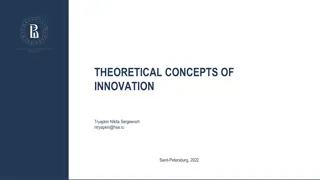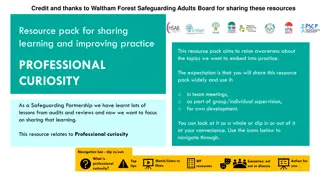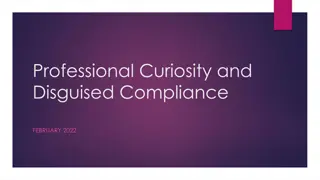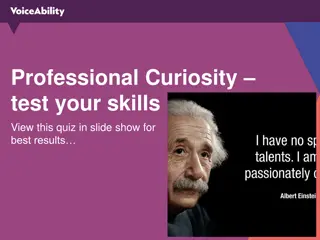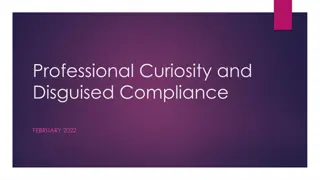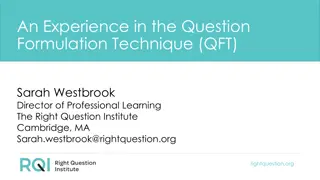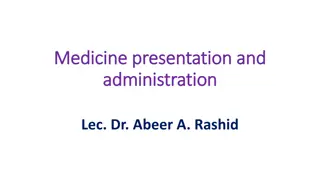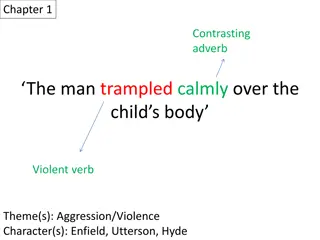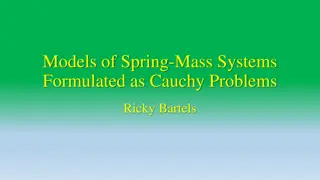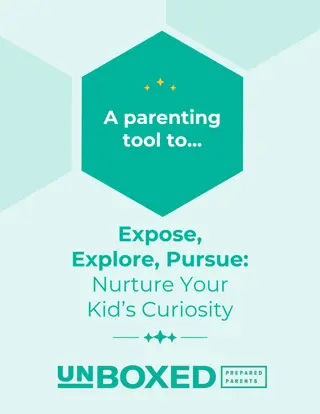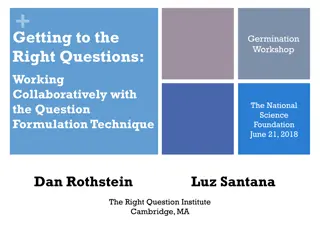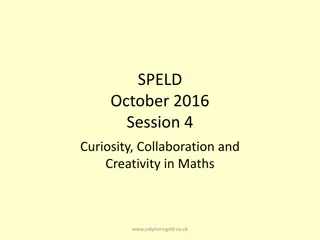Cultivating Curiosity and Innovation Through Question Formulation
Explore the transformative power of teaching students to ask their own questions with the insights shared by Sarah Westbrook, Director of Professional Learning at The Right Question Institute. Discover the importance of question formulation in driving learning, fostering innovation, and sparking curiosity. Join a collaborative session to delve into classroom applications, share reflections, and engage in interactive learning experiences. Access free resources and participate in a hybrid session to enhance your teaching practices.
Download Presentation

Please find below an Image/Link to download the presentation.
The content on the website is provided AS IS for your information and personal use only. It may not be sold, licensed, or shared on other websites without obtaining consent from the author.If you encounter any issues during the download, it is possible that the publisher has removed the file from their server.
You are allowed to download the files provided on this website for personal or commercial use, subject to the condition that they are used lawfully. All files are the property of their respective owners.
The content on the website is provided AS IS for your information and personal use only. It may not be sold, licensed, or shared on other websites without obtaining consent from the author.
E N D
Presentation Transcript
Spark Curiosity, Fuel Innovation, and Drive Learning: Teach Students to Ask Their Own Questions Sarah Westbrook Director of Professional Learning The Right Question Institute, Cambridge, MA rightquestion.org
Acknowledgments We are deeply grateful to The Hummingbird Fund, the Library of Congress, and to the Right Question Institute board of directors for their support of our work. Many thanks to Yolanda Hu and Jessica Cohen for all of their work behind the scenes in preparation for this presentation.
Todays Agenda 1) 2) 3) Welcome and Introductions Why Spend Time on Teaching Question Formulation? Collaborative Learning with the Question Formulation Technique (QFT) Explore Classroom Applications & Student Work with Jessica Cohen Closing Words and Final Reflections and Questions 4) 5)
This will be a hybrid session. Over the course of the session, you will: Discuss with your group Type responses from the group in the chat box. One person in each group should be logged into the video call (on mute) on their computer. Work with your group on the piece of paper on your table
To join the video conference: https://cloud.xylink.com/page/j/Y04S6XHU Room Number: 90001291043 Password: 777777
Access Todays Materials and All of Our Free Resources https://rightquestion.org/events/
Use and Share These Resources The Right Question Institute offers materials through a Creative Commons License. You are welcome to use, adapt, and share our materials for noncommercial use, as long as you include the following reference: Source: The Right Question Institute (RQI). The Question Formulation Technique (QFT) was created by RQI. Visit rightquestion.org for more information and free resources.
+ Why spend time teaching the skill of question formulation?
Honoring the Original Source: Parents in Lawrence, Massachusetts, 1990 We don t go to the school because we don t even know what to ask.
"There is no learning without having to pose a question." - Richard Feynman Nobel Laureate, Physics, 1965
it is always okay to dig deeper, to press harder, to question things that seem obvious. This insistent curiosity is at the heart of many deep problems... Adina Roskies Professor of Philosophy, Dartmouth College
We must teach students how to think in questions, how to manage ignorance. Stuart Firestein Former chair, Department of Biology, Columbia University
College Presidents on What College Students Should Learn The primary skills should be analytical skills of interpretation and inquiry. In other words, know how to frame a question. - Leon Botstein, President of Bard College the best we can do for students is have them ask the right questions. - Nancy Cantor, Former Chancellor of University of Illinois The New York Times, August 4, 2002
Yet, Only 27% of Graduates Believe College Taught Them How to Ask Their Own Questions Alison Head, Project Information Literacy at University of Washington, 2016
Question Asking Declines with Age Tizard, B., Hughes, M., Carmichael, H., & Pinkerton, G. (1983). Dillon, J. T. (1988).
Question Formulation by Adolescence Who s asking questions over the course of an hour? Educators Students Dillon, 1988, p. 199 rightquestion.org
We can work together on creating more opportunities for students to ask their own questions
We Are Not Alone More than 1 million classrooms worldwide
What happens when students do learn to ask their own questions?
Research Confirms the Importance of Questioning Self-questioning (metacognitive strategy): Student formulation of their own questions is one of the most effective metacognitive strategies Engaging in pre-lesson self-questioning improved students rate of learning by nearly 50% (Hattie, p.193) John Hattie Visible Learning: A Synthesis of Over 800 meta-Analyses Relating to Achievement, 2008
Student Reflection The way it made me feel was smart because I was asking good questions and giving good answers. -Boston 9th grade summer school student
+ Collaborative Learning with the Question Formulation Technique (QFT)
The Question Formulation Technique (QFT) Students learn to: Produce their own questions Improve their questions Strategize on how to use their questions Reflect on what they have learned and how they learned it
QFT Set Up Please raise your hand if you will writing for your group. You will be your group s scribe. Please raise your hand if you will monitor the chat box for your group. You may be asked to either relay information from the chat box or enter information in the chat box.
Rules for Producing Questions 1. Ask as many questions as you can 2. Do not stop to answer, judge, or discuss 3. Write down every question exactly as stated 4. Change any statements into questions
Produce Questions 1. Ask Questions 2. Follow the Rules Ask as many questions as you can. Do not stop to answer, judge, or discuss. Write down every question exactly as it was stated. Change any statements into questions. 3. Number the Questions
Question Focus Some students are not asking questions. Please write this statement at the top of your paper. Remember: Number the questions. Follow the rules.
Categorize Questions: Closed/Open Definitions: Closed-ended questions can be answered with a yes or no or with a one-word answer. Open-ended questions require more explanation. Directions: Identify your questions as closed-ended or open-ended by marking them with a C or an O.
Discussion Closed-ended Questions Advantages Disadvantages
Discussion Open-ended Questions Advantages Disadvantages
Transform Questions Take one closed-ended question and change itinto an open- ended question. Closed Open Take one open-ended question and change itinto a closed- ended question. Open Closed
Prioritize Questions Review your list of questions Choose the three questions you consider most important. While prioritizing, think about your Question Focus: Some students are not asking questions. After prioritizing consider Why did you choose those three questions? Where are your priority questions in the sequence of your entire list of questions?
Action Plan From priority questions to action plan In order to answer your priority questions: What do you need to know? Information What do you need to do? Tasks
Action Plan In order to answer your priority questions: What do you need to know? Information What do you need to do? Tasks Information Tasks
Share 1. Questions you changed from open/closed 2. Your three priority questions and their numbers in your original sequence 3. Rationale for choosing priority questions 4. Your action plan
Reflect What did you learn? How did you learn it? What do you understand differently now about some students not asking questions?
The QFT, on one slide 1. Ask as many questions as you can 2. Do not stop to discuss, judge or answer 3. Record exactly as stated 4. Change statements into questions 1) Question Focus 2) Produce Your Questions Follow the rules Number your questions 3) Improve Your Questions Categorize questions as Closed or Open-ended Change questions from one type to another 4) Strategize Prioritize your questions Action plan or discuss next steps Share 5) Reflect Closed-Ended: Answered with yes, no or one word Open-Ended: Require longer explanation Source: The Right Question Institute rightquestion.org
Curiosity and Rigor Three thinking abilities with one process
Thinking in many different directions Divergent Thinking
Narrowing Down, Focusing Convergent Thinking
Thinking about Thinking Metacognition
Todays Agenda 1) 2) 3) Welcome and Introductions Why Spend Time on Teaching Question Formulation? Collaborative Learning with the Question Formulation Technique (QFT) Explore Classroom Applications & Student Work with Jessica Cohen Closing Words and Final Reflections and Questions 4) 5)
+ Exploring Classroom Examples
Classroom Example: 4th Grade Teacher: Deirdre Brotherson, Hooksett, NH Topic: Math unit on variables Purpose: To engage students at the start of a unit on variables and assess their current skill level
Question Focus 24 = + +
Student Questions 1. Why is the 24 first? 2. What do the smiley faces mean? 3. Why are there 3 smiley faces? 4. How am I suppose to figure this out? 5. Is the answer 12? 6. Can I put any number for a smiley face? 7. Do three faces mean something? 8. Do the numbers have to be the same because the smiley faces are the same? 9. What numbers will work here? 10.Does it mean 24 is a really happy number? 11.Can we replace each smiley face with an 8? 12.Do any other numbers work? 13.Can we do this for any number? 14.Does it always have to be smiley faces? 15.Do we always have to use three things?
Next Steps Questions were hung around the room. Students checked off questions as they were answered during the rest of the unit. At the end of the unit, students analyzed their original list of questions and discussed what they learned and what they still wanted to know.




